Highlights from the Northeast Astronomy Forum 2018
June 1, 2018
By: Brian Ventrudo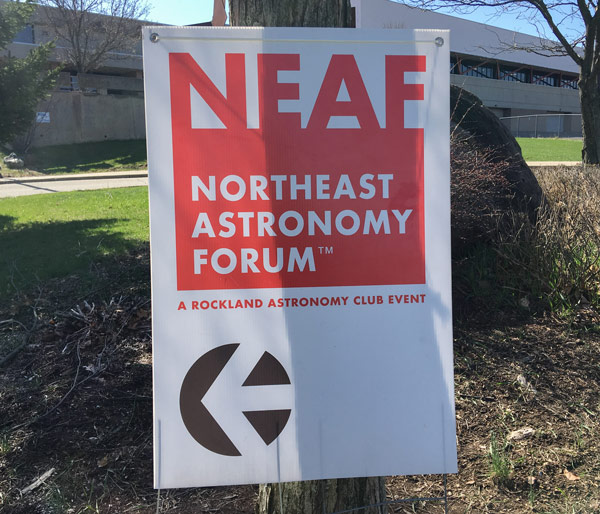 The Northeast Astronomy Forum (NEAF) was held on April 21-22, 2018 in Suffern, NY.
The Northeast Astronomy Forum (NEAF) was held on April 21-22, 2018 in Suffern, NY.Overview
The Northeast Astronomy Forum (NEAF) was held on April 21-22, 2018 at Rockland Community College in Suffern, NY. The annual show is organized and hosted by the Rockland Astronomy Club, and it's a great place to see the latest in astronomy gear, catch up with old friends and acquaintances, and hear excellent talks on recent developments in astronomy and space science. Here are a few highlights and images of this year's show, with an emphasis on new products and developments in the field of amateur astronomy.
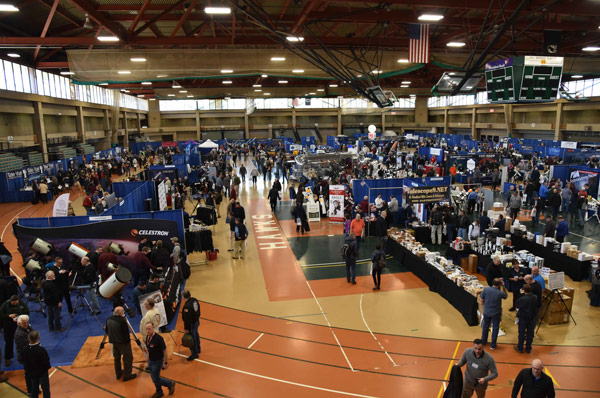 The action on the floor at NEAF 2018.
The action on the floor at NEAF 2018.Celestron
Celestron had a handful of new products on display, the most impressive of which was their 36cm (14-inch) Rowe-Ackerman Schmidt Astrograph (RASA). This big instrument has been in production for about a year, shipping mostly to professional observatories for wide-field imaging and tracking of NEOs, but shipments may soon begin to amateur imagers with deep pockets and a hefty mount. The OTA weighs in at about 75 lbs and costs some $13,000.
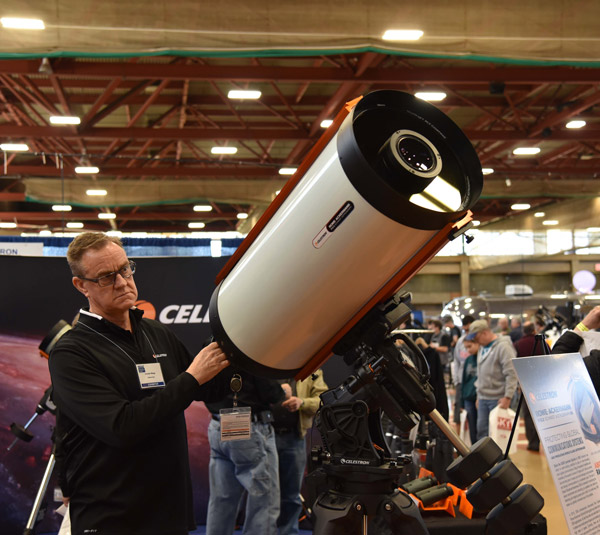 Celestron's new 36cm Rowe-Ackerman Schmidt Astrograph (RASA) on a CGX-L mount.
Celestron's new 36cm Rowe-Ackerman Schmidt Astrograph (RASA) on a CGX-L mount.Celestron also announced a high-capacity portable Powertank Lithium Pro that features up to 17 hours of power for a telescope mount and other accessories. It also features 2 USB ports for charging electronic devices and a 12V cigarette-lighter port to power electronics or camping gear. The tank meets current FAA regulations for carry-on baggage and uses inherently stable lithium iron phosphate batteries. This product is the big brother to the Celestron Powertank Lithium.
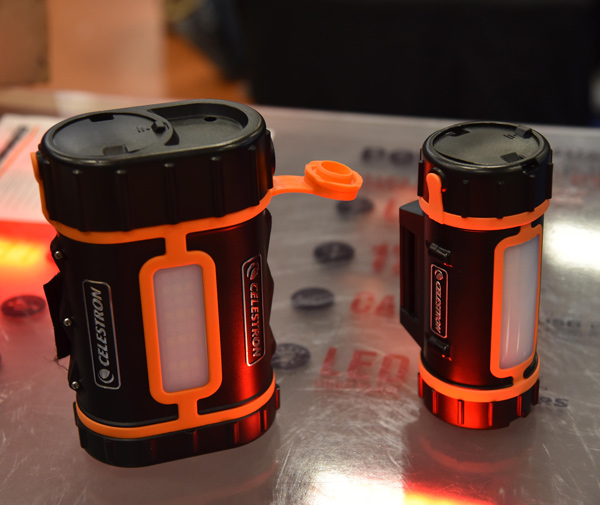 The Celestron Powertank Lithium Pro (left) and Powertank Lithium (right)
The Celestron Powertank Lithium Pro (left) and Powertank Lithium (right)While it looks a little complicated at first, Celestron's new NexYZ 3-axis universal smartphone adapter generated a fair bit of interest at the show. This robust adapter holds pretty much any smartphone, including a case, and allows quick and precise alignment of the phone's camera to the eyepiece. And it costs less than $60.
Celestron also released a newly-branded version of their little starter Dobsonian, the FirstScope. Now called the FirstScope Signature Series by Robert Reeves, the 76mm table-top Dob features a simple lunar map on the tube and mount and a free download of Reeves' e-book Lunar Landscapes.
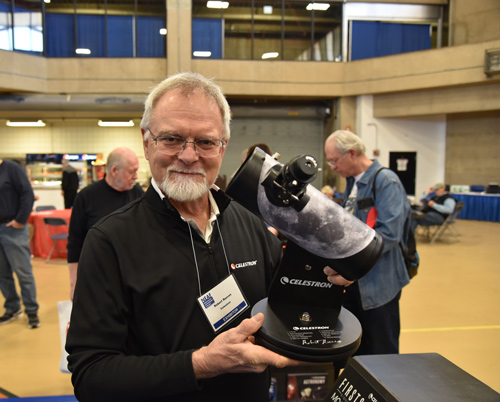 Lunar observer Robert Reeves and the new Celestron FirstScope Signature Series 3" Dob.
Lunar observer Robert Reeves and the new Celestron FirstScope Signature Series 3" Dob.ZWO
Sam Wen and his team from ZWO had a small but busy booth at NEAF this year. They had several cameras on display including a new ASI120MM-Mini autoguiding camera with USB2.0 interface. They also had a prototype of their new ASlair module at the booth. This little module, due for release in July 2018, is a Wi-Fi hub that allows control of a mount, camera, guider, alignment through plate solving, among other features, all through a specialized app on a cell phone or tablet. The price has not been announced, but ZWO is making engineering efforts to keep this module affordable.
ZWO also has new monochrome cameras in the works for the coming year.
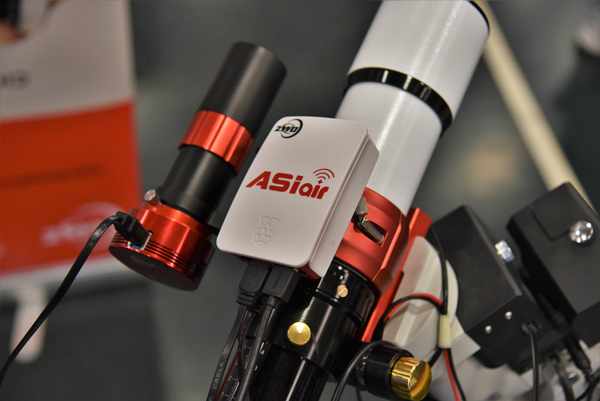 The ZWO ASIair WiFi camera control module
The ZWO ASIair WiFi camera control moduleTele Vue Optics
Al Nagler and the folks at Tele Vue were hard at work all weekend showing their telescopes and eyepieces in action. They also had their new Bandmate filters on display. These filters come in versions that pass OIII, H-Beta, or both (called the Nebustar). These filters are made to exacting mechanical and optical specifications by Astronomik.
Tele Vue also had their relatively new TVNC night vision system on display. This little jewel is a collaboration between Tele Vue and the Tactical Night Vision Company. It includes the TVN/PVS-14 night-vision monocular and a custom adapter to connect it to any Tele Vue eyepiece that's Dioptrx compatible. The display showed a simulated star field with a regular DeLite eyepiece and with the TVNC monocular and a DeLite. The difference was astonishing. The monocular rendered the star field in a gray scale rather than in a green color that is more common with night-vision technology. It was very impressive, although the cost and export restrictions of this technology will make this a niche product for now.
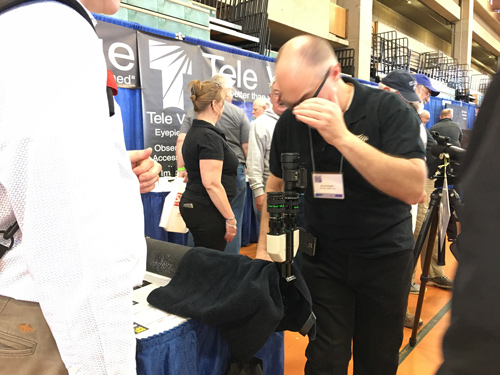 David Nagler of Tele Vue Optics demonstrates the TVNC night vision system with a DeLite eyepiece
David Nagler of Tele Vue Optics demonstrates the TVNC night vision system with a DeLite eyepieceSTC Filters
The Taiwanese company SCT Optical Filters was at NEAF showing their excellent line of photographic and astronomy filters. The latter line includes threaded filters for camera lenses and clip filters for DSLRs and mirrorless cameras. Their astronomy filters include a duo-band filter to pass OIII and H-alpha for imaging, a multi-spectral filter for general light pollution reduction and color fidelity for imaging with DSLRs. These filters have a waterproof Nano Anti-Smudge coating to keep water and grease off the optic. Agena will be carrying a selection of these filters in the near future.
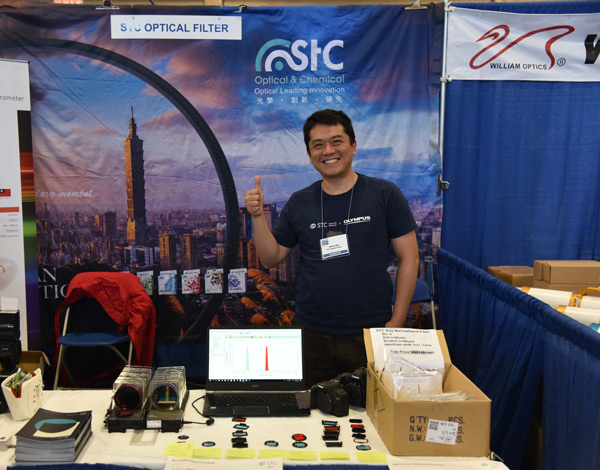 William Wu of STC Optical Filters in Taiwan
William Wu of STC Optical Filters in TaiwanSky and Telescope
Sky and Telescope had a strong presence at the show, and many of their editors were available to discuss astronomical matters. To offset the loss of ad revenue, a common problem in the magazine business, they continue to offer several interesting tour packages to see astronomical events throughout the world. They also had star atlases and globes at the show including a prototype of a small Pluto globe based on recent observations from the New Horizons spacecraft that flew by the dwarf planet in 2015.
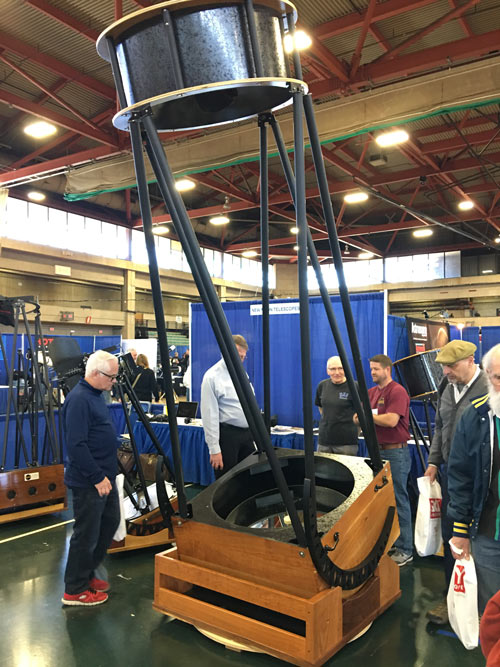 The largest telescope on the NEAF 2018 floor, a 36-inch Dobsonian by New Moon Telescopes
The largest telescope on the NEAF 2018 floor, a 36-inch Dobsonian by New Moon TelescopesSky-Watcher
Sky-Watcher USA is finally moving to re-brand their telescope lines to conform to their international operations. That means the name and look of many of their telescopes will change in the coming months. The ProED refractors will be called Evostar; Mak-Cassegrains will be Skymax; Mak-Newtonians will be Starlux; Traditional Dobsonians will be Classic Dobsonians; and their Collapsible Dobsonians will be Flextube Dobsonians. They had many of these scopes on display with the new green trim. The difference from the old scopes isn't huge, but it is noticeable.
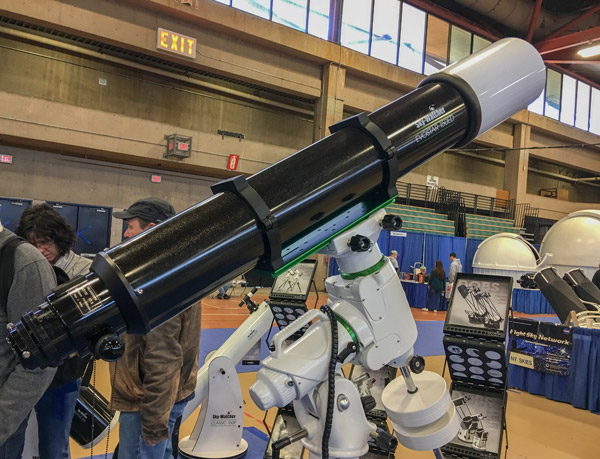 The new Sky-Watcher Evostar 150 ED refractor with new green trim. The sparkly black tube remains.
The new Sky-Watcher Evostar 150 ED refractor with new green trim. The sparkly black tube remains.They also have a new lightweight EQM-35 mount. This compact equatorial mount has a capacity of about 22 lbs, and it also features a removable declination axis to reduce the weight of the mount head. In this configuration, it can be used for tracking in the RA axis only for astrophotography with a DSLR and lens.
Sky-Watcher also announced a new WiFi module for their SynScan controllers, and they released handful of new telescopes including 72mm Evostar and 150mm Evostar refractors, a 50mm Evoguide guide scope, and some new Maks. All these products are expected out in June.
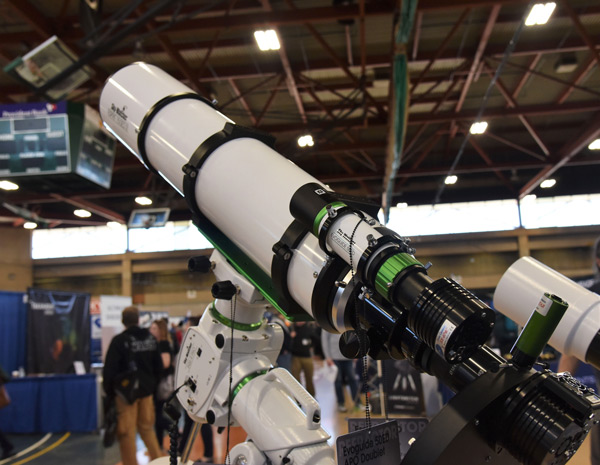 Sky-Watcher Evoguide 50mm guide scope riding on a 150mm Esprit refractor
Sky-Watcher Evoguide 50mm guide scope riding on a 150mm Esprit refractorExplore Scientific
Explore Scientific had a big booth and their beautiful silver Airstream trailer on site (aka 'Barbara Jean'). They had a lovely 152mm ED refractor on display listed for about $10,000. They also had a new 20" truss-tube Dobsonian, a remarkably compact instrument with a focal ratio of f/3.6 and a price of $8,600.
On the eyepiece display table was a couple of prototypes of their new 52-degree eyepieces. A quick look revealed a comfortable eye relief, far better than a Plossl, and characteristically good build quality. These are expected out later this summer.
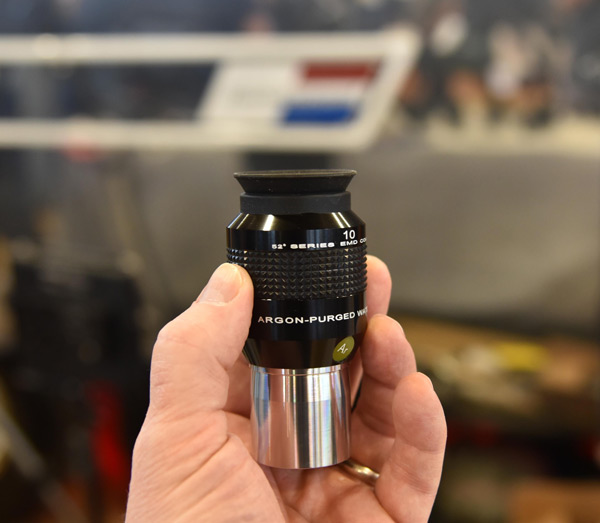 A demo version of a new 52-degree Explore Scientific eyepiece
A demo version of a new 52-degree Explore Scientific eyepieceWilliam Optics
William Optics had plenty of their pretty telescopes on display including a pair of their new GT153 153mm refractors. They also had their lovely new WO-EQ35 Equatorial Mount & A-Z103 Package on the floor. The William Optics branded mount is produced by and very similar to the Sky-Watcher EQM-35 mount and comes with a pier and tripod.
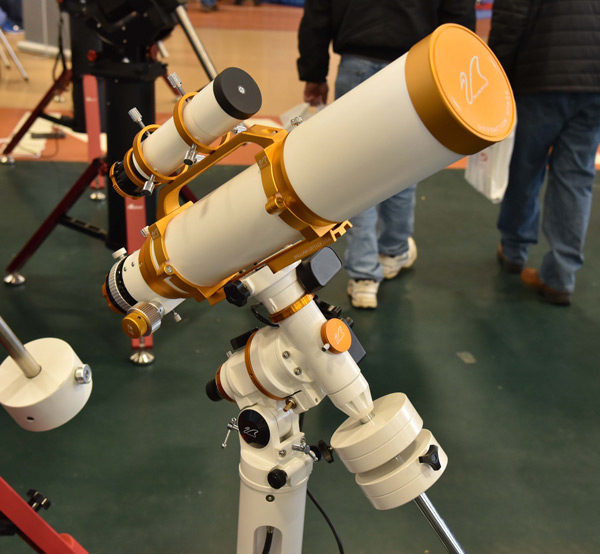 The William Optics WO-EQ35 Equatorial Mount and A-Z103 refractor
The William Optics WO-EQ35 Equatorial Mount and A-Z103 refractorDaystar Filters
Daystar Filters had perhaps the most unusual and innovative new mount at NEAF. Called the Zerostar, this dual-arm mount and tripod are made of carbon fiber and powered with a built-in lithium-ion battery. The capacity of the mount is 50lbs, yet the entire assembly, including tripod, weighs just 12lbs. It's easy to lift with one hand! The mount is completely self-aligning, even in daytime. The cost? About $3,600!
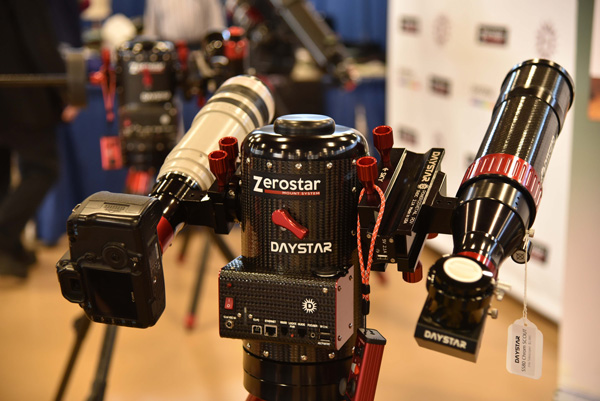 The Daystar Filter Zerostar self-aligning carbon fiber mount
The Daystar Filter Zerostar self-aligning carbon fiber mountNEAF Talks
The show also featured several talks by space and astronomy experts, including an expansive lecture by the Nobel Prize winner John Mather from NASA Goddard about the past and future of the universe, no less.
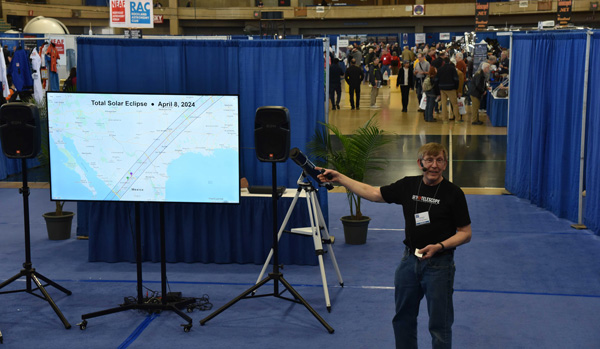 Kelly Beatty of Sky and Telescope discusses the observing prospects for upcoming solar eclipses
Kelly Beatty of Sky and Telescope discusses the observing prospects for upcoming solar eclipsesKelly Beatty of Sky and Telescope explained the observing prospects for the next several total and annular eclipses through 2024. The eclipses in South America in 2019 and 2020 are promising if you can get to the right location. And the next North American eclipse of 2024 will be a significant event, but it may not have optimal weather prospects compared to the 2017 eclipse because it happens in early northern spring. The best weather in the U.S. for this eclipse is likely in southwest Texas.
David Eicher (at right) moderates a panel discussion on the future of amateur astronomy with, from left to right, Will Clodfelder, Pranvera Hyseni, and Grant Regen.
Finally, on Sunday, three young astronomers each gave a short talk on 'Future of Amateur Astronomy' followed by a panel discussion moderated by David Eicher of Astronomy magazine. Two of the speakers were impressive high-school seniors who are off to study astronomy at major universities. The third, Pranvera, Hyseni, has almost single-handedly founded an astronomy outreach program in her native Kosovo. Although all three are well versed in the modern art of social media, and they are well aware of the fleeting attraction of the overwhelming deluge of astronomical images on the internet, they all agreed on one thing: to attract newcomers to amateur astronomy, the best approach is to give them a look through a telescope at a showpiece object like the Moon, Saturn, or a colorful double star or star cluster. In other words, the real thing. Very heartening indeed.
 About the Author
About the Author
Brian Ventrudo is a writer, scientist, and astronomy educator. He received his first telescope at the age of 5 and completed his first university course in astronomy at the age of 12, eventually receiving a master's degree in the subject. He also holds a Ph.D. in engineering physics from McMaster University. During a twenty-year scientific career, he developed laser systems to detect molecules found in interstellar space and planetary atmospheres, and leveraged his expertise to create laser technology for optical communications networks. Since 2008, Brian has taught astronomy to tens of thousands of stargazers through his websites OneMinuteAstronomer.com and CosmicPursuits.com.
***
This article is © AstronomyConnect 2018. All rights reserved.
Please login or register to watch, comment, or like this article.
-
Final Announcement: We're Saying Goodbye to AstronomyConnect. Read Our Closing Notice.
Dismiss Notice
New Cookie Policy
On May 24, 2018, we published revised versions of our Terms and Rules and Cookie Policy. Your use of AstronomyConnect.com’s services is subject to these revised terms.

